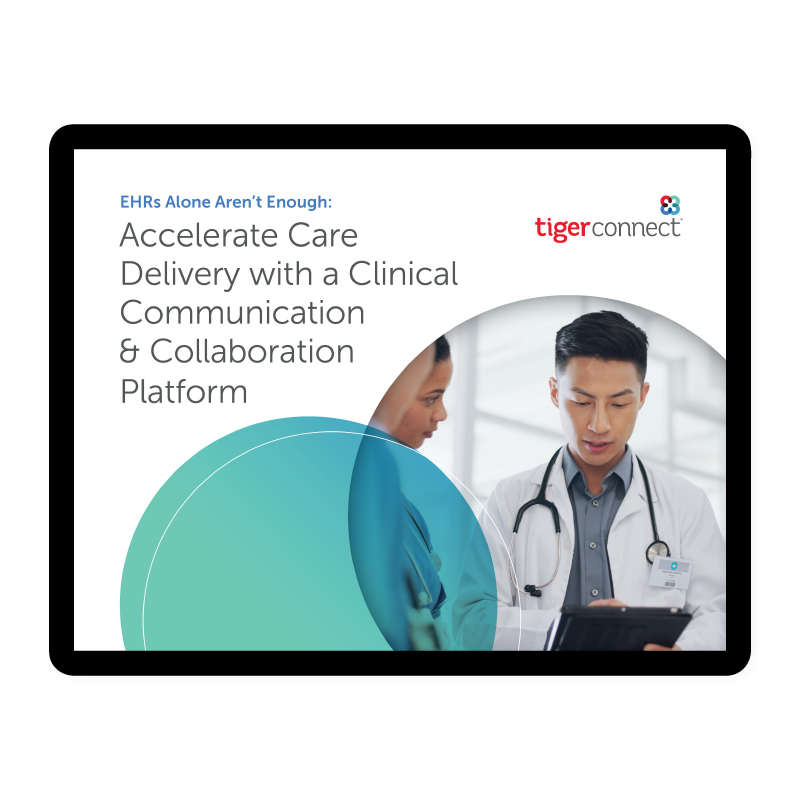Home / Blog /
Why EHR Communication Falls Short in Urgent Situations

Why EHR Communication Falls Short in Urgent Situations
Hospitals Need Communication Tools That Speed Care Delivery, Not Slow it Down
We all know that in the world of healthcare, every second counts. When it comes to emergencies, those precious seconds can be the difference between life and death. In fact, delays in rapid response calls contribute to 34.7% higher in-hospital mortality, according to the NIH.
Now, many hospitals have a tempting communication option right at their fingertips – an EHR chat feature that often comes with their EHR license at little to no additional cost. But here’s the catch: relying on EHR chat during critical moments can actually put patients at risk. We’re talking about life-threatening events, such as strokes and code blue, where fast communication across the care team can mean everything.
EHRs Alone Aren’t Enough
|
 |
The need for speed in healthcare: your EHR wasn’t designed for urgent communication
EHR chat, as you may have experienced, doesn’t enable quick response times. For one, it can be cumbersome to regularly log in to, which slows response times. Users are logged out so frequently that the 2-factor authentication process needs to be repeated nearly every time you receive a message, leading to a frustrating user experience and low adoption. Furthermore, not everyone has EMR access, which means that communication takes place in disjointed systems. For these reasons, EHR vendors themselves advise against using EHR chat for urgent communications and explicitly state that EHR chat should not be used for emergency communications.
So, what do hospitals do instead? Well, some turn to old-school methods like pagers, overhead paging, or even frantic phone calls during emergencies. But if you’ve ever had to page someone twice to get ahold of them, or scramble to find the on-call provider’s phone number, it’s easy to understand why these backup methods aren’t ideal when a patient’s life is on the line.
Care teams are only as fast as their communication tools allow them to be. To speed care delivery in an emergency, you need tools that go beyond clunky chat interfaces, disjointed phone calls, and overhead alerts. A clinical communication and collaboration (CC&C) platform helps hospitals achieve greater efficiency around critical response workflows (like code blue, sepsis, STEMI, strokes, and critical labs) to ultimately deliver better care, faster.
Hospitals need communication solutions designed to speed response times
The TigerConnect Clinical Collaboration Platform fills the gaps left by EHRs with a communication system designed to dramatically speed response time from triage to treatment. Imagine being able to quickly message specific roles, like the ‘radiologist on-call,’ and activate pre-defined teams, ensuring everyone is in the loop without delay. And unlike an EHR, you don’t even need to know the provider’s name and can search by functional role or specialty.
Escalation pathways, integrations with your EHR, and role and team-based workflows significantly improve response times for critical response workflows. Take sepsis for instance. In a typical workflow, when sepsis indicators are met in the EHR, the nurse calls the operator to initiate a code, and the operator pages the sepsis team. A series of phone calls are made to coordinate labs and treat the patient, with the total sepsis workflow taking 80+ minutes. But with TigerConnect, when sepsis indicators are met in the EHR, all members of the ‘Sepsis Response Team’ automatically receive a priority alert to their mobile devices with relevant patient information. Since TigerConnect Roles and Teams populate from your clinicians’ schedules, the right people are notified every time, and the workflow takes only 37 minutes.
Real results, real lives saved
By keeping communication separate from EHR workflows with TigerConnect, providers will save time and have less disruptions while ensuring that messages are acknowledged and responded to in a timely fashion. Organizations have been able to significantly improve patient outcomes by using TigerConnect to expedite care team workflows:
- Temple Health integrated TigerConnect with its EHR to send a sepsis alert to the appropriate team members as soon as key indicators are met in the EHR. Early prediction and intervention with TigerConnect led to a 30-40% decrease in sepsis mortality.
- Baylor St. Luke’s Medical Center (BSLMC) integrated TIgerConnect with a clinical decision support tool to enable real-time stroke alerts and address their treatment time challenges. BSLMC reduced door-to-needle time by 50% for strokes, saving 75 lives annually.
- Geisinger Health adopted TigerConnect as an enterprise-wide initiative and integrated it with their Epic EHR and other critical systems to close the loop on critical lab alerts. As a result, the team reduced critical lab delivery time by 73%.
- The University of Maryland Medical System integrated TigerConnect with their EHR to automate alerts and enable real-time communication for their code blue team, and accelerated response times by 2.5 minutes. The result: 8% higher survival to discharge.
Conclusion
When it comes to adopting a communication solution for your hospital, you need more than just support – you need speed, especially during those critical, time-sensitive emergencies. TigerConnect steps in to seamlessly merge communication and patient data, delivering actionable notifications directly to your mobile device. By automating workflows, speeding response times, and dramatically improving patient outcomes, TigerConnect is your lifeline when every second counts. And with 99.995% verifiable uptime – and no planned downtime – you’ll always reach the right person at the right time, so patients get the lifesaving care they need.
Will O'Connor M.D., CMIO at TigerConnect
Will O’Connor, M.D. is the Chief Medical Information Officer at TigerConnect. As a physician executive with more than 20 years of healthcare experience, Will is a passionate advocate for rapid advancement across the healthcare industry.
Tags: delays in rapid response calls, epic secure chat, cerner care aware, EHR communication, rapid response, speed care delivery, critical response








